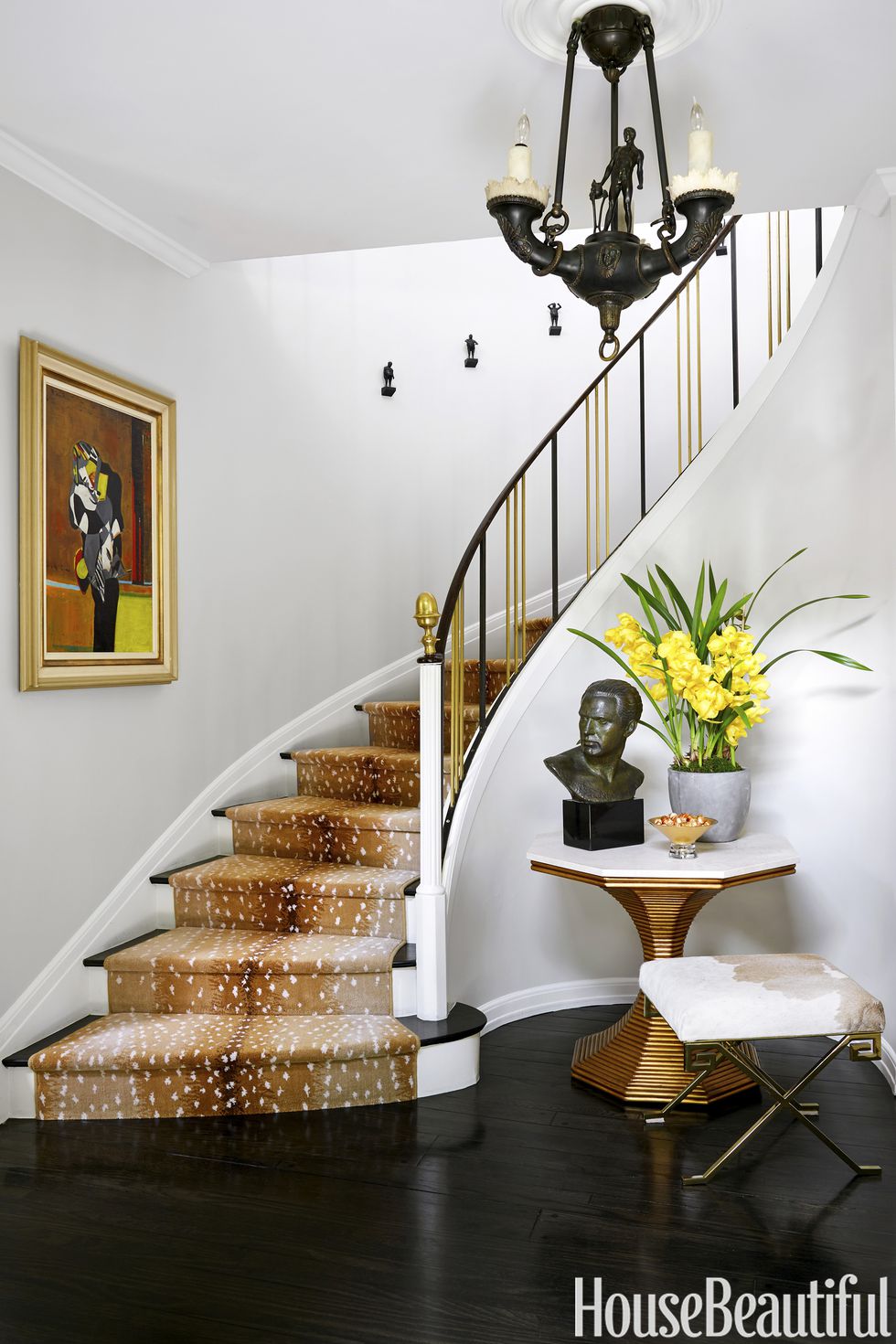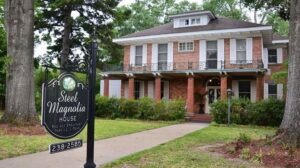When it comes to home design, there is often a desire to adhere to a certain era or style. However, sometimes the most captivating homes are those that break the mold and go off script. Such is the case with a 1930s Regency-style home that has been transformed into a modern masterpiece. This article will explore the journey of this remarkable residence, offering valuable insights into the design choices, inspirations, and unique features that make it truly one-of-a-kind.
The History of Regency-Style Architecture
Regency architecture emerged in the early 19th century in England during the Regency era, which spanned from 1811 to 1820. It was a period of transition between the Georgian and Victorian eras, characterized by a distinct departure from the strict symmetry and formality of the Georgian style. Regency architecture embraced a more romantic and whimsical aesthetic, with curved lines, ornate embellishments, and an emphasis on natural light.
During the 1930s, there was a resurgence of interest in Regency-style architecture, particularly in the United States. Many affluent homeowners sought to recreate the elegance and grandeur of the original Regency period, resulting in the construction of numerous Regency-inspired homes.
The Transformation Begins
Fast forward to the present day, where an ambitious homeowner with a passion for design and a keen eye for detail decided to take a 1930s Regency-style home in a new direction. This homeowner, let's call them Sarah, saw the potential to create something truly exceptional by blending the charm of the original architecture with modern elements.
The transformation began with extensive research into Regency architecture, examining the key elements that defined the style. Sarah wanted to preserve the essence of the era while infusing it with her own unique vision. This approach would ultimately result in a harmonious blend of old and new.
Preserving the Regency Aesthetic
One of the primary goals of the renovation was to maintain the Regency aesthetic that permeated the home. This involved careful restoration of the original features, including the ornate plasterwork, intricate moldings, and elegant archways. The attention to detail was meticulous, with skilled craftsmen working tirelessly to bring the home back to its former glory.
Additionally, Sarah made a conscious effort to source authentic Regency-era furniture and decor to populate the interior spaces. This included delicate chandeliers, vintage wallpaper, and period-specific artwork. Every piece was chosen with the utmost care to ensure that it complemented the overall design scheme.
A Modern Twist
While the desire to preserve the Regency aesthetic was strong, Sarah also wanted to infuse the home with a modern twist. This involved incorporating contemporary materials, finishes, and design elements that would create a striking contrast to the historic features.
One example of this can be seen in the kitchen, where sleek, minimalist cabinetry and state-of-the-art appliances coexist with the original marble countertops and ornate ceiling medallions. The result is a space that seamlessly blends old and new, creating a visually captivating and highly functional area.
Maximizing Natural Light
One of the defining characteristics of Regency architecture is its emphasis on natural light. This was an aspect that Sarah sought to enhance during the renovation. Large, floor-to-ceiling windows were installed throughout the home, flooding the interior spaces with an abundance of light. This not only brightened the rooms but also accentuated the architectural details, creating a sense of grandeur and elegance.
Moreover, Sarah strategically placed mirrors in various areas of the house to further amplify the natural light and create the illusion of more space. This technique, commonly used in Regency design, helped to make the home feel even more open and inviting.
Creating Outdoor Oasis
Another aspect that Sarah wanted to focus on was the outdoor space. The original Regency-style homes often featured expansive gardens and meticulously manicured landscapes. Sarah wanted to honor this tradition while incorporating modern elements that would make the outdoor area a true oasis.
She enlisted the help of a landscape architect to design a garden that would be both visually stunning and functional. The result was a harmonious blend of lush greenery, vibrant flowers, and contemporary outdoor furnishings. The garden became an extension of the home, offering a tranquil retreat where Sarah could relax and entertain.
Unique Features That Set This Home Apart
Throughout the renovation process, Sarah incorporated several unique features that set this home apart from others in the area. These features not only added visual interest but also enhanced the functionality and livability of the space.
1. A Rooftop Terrace
One standout feature of the home is the addition of a rooftop terrace. This was a bold move that required careful engineering and structural planning. The terrace offers breathtaking views of the surrounding neighborhood and serves as a private sanctuary where Sarah can unwind and enjoy the outdoors.
2. A Hidden Wine Cellar
Hidden behind a bookshelf in the study is a secret wine cellar. This unexpected feature adds an element of intrigue and surprise to the home. The cellar is climate-controlled and can store an impressive collection of wines, making it a true connoisseur's delight.
3. A Home Theater
For those cozy movie nights, Sarah decided to convert one of the original drawing rooms into a state-of-the-art home theater. The room was acoustically treated, and plush seating was installed to create the ultimate cinematic experience. This addition demonstrates how a historic home can be adapted to meet the needs and desires of modern living.
4. A Modern Art Gallery
One of Sarah's passions is contemporary art, and she wanted to showcase her extensive collection in a way that would complement the historic surroundings. She transformed a hallway into a modern art gallery, complete with carefully curated lighting and minimalist display panels. This unexpected juxtaposition of old and new creates a captivating visual experience for visitors.
Frequently Asked Questions
1. How long did the renovation process take?
The renovation process took approximately two years from start to finish. This included extensive planning, sourcing of materials, and coordination of various contractors and craftsmen.
2. What were the biggest challenges faced during the renovation?
One of the biggest challenges was finding skilled craftsmen who could replicate the intricate plasterwork and moldings that were characteristic of the Regency style. Additionally, integrating modern elements without compromising the historical integrity of the home required careful thought and planning.
3. How did the renovation impact the value of the home?
The renovation significantly increased the value of the home. The unique blend of historic charm and modern design elements created a property that stands out in the market. Potential buyers are drawn to the character and individuality of the home, making it highly desirable.
4. Can elements of this design be incorporated into other styles of homes?
Absolutely! The principles of blending old and new, maximizing natural light, and creating unique features can be applied to any style of home. The key is to carefully consider the existing architecture and find ways to enhance its best features while adding contemporary elements that complement the overall design.
5. What advice would you give to someone considering a similar renovation?
My advice would be to do thorough research and planning before embarking on the renovation journey. Understand the history and architectural style of your home, and consider how you can enhance its unique features while incorporating modern elements. Work with skilled professionals who share your vision and can bring it to life.
In Conclusion
The transformation of this 1930s Regency-style home is a testament to the power of vision and creativity. By going off script and blending old and new, the homeowner has created a truly remarkable residence that captivates the imagination. The careful preservation of the Regency aesthetic, combined with modern twists and unique features, has resulted in a home that is both visually stunning and highly functional. This project serves as an inspiration to homeowners and designers alike, showing that with the right approach, any home can be transformed into a work of art.
Frequently Asked Questions
1. How long did the renovation process take?
The renovation process took approximately two years from start to finish. This included extensive planning, sourcing of materials, and coordination of various contractors and craftsmen.
2. What were the biggest challenges faced during the renovation?
One of the biggest challenges was finding skilled craftsmen who could replicate the intricate plasterwork and moldings that were characteristic of the Regency style. Additionally, integrating modern elements without compromising the historical integrity of the home required careful thought and planning.
3. How did the renovation impact the value of the home?
The renovation significantly increased the value of the home. The unique blend of historic charm and modern design elements created a property that stands out in the market. Potential buyers are drawn to the character and individuality of the home, making it highly desirable.
4. Can elements of this design be incorporated into other styles of homes?
Absolutely! The principles of blending old and new, maximizing natural light, and creating unique features can beapplied to any style of home. Whether it's a mid-century modern, Victorian, or even a contemporary style home, the concept of blending old and new can create a captivating and unique living space.
5. What advice would you give to someone considering a similar renovation?
If you're considering a similar renovation, my advice would be to start with a clear vision of what you want to achieve. Research the history and architectural style of your home to understand its unique features and characteristics. This will help you determine how to preserve and enhance those elements while incorporating modern design elements.
Work with skilled professionals who have experience in both historic preservation and modern design. They can help you navigate the challenges of blending old and new, ensuring that the final result is cohesive and harmonious.
Plan your budget carefully and allow for some flexibility. Renovations can often uncover unexpected issues or opportunities, so it's important to have some room for adjustments. Set realistic timelines and be prepared for the process to take longer than expected.
Finally, trust your instincts and have fun with the process. Renovating a home is an opportunity to create something truly unique and personalized. Embrace the journey and enjoy seeing your vision come to life.
Summary
The transformation of a 1930s Regency-style home into a modern masterpiece is a testament to the power of creativity and vision. By going off script and blending old and new, the homeowner has created a truly remarkable residence that captivates the imagination. The preservation of the Regency aesthetic, combined with modern twists and unique features, has resulted in a home that is both visually stunning and highly functional.
Throughout the renovation process, careful attention was given to preserving the historical integrity of the home while incorporating contemporary elements that enhance its livability. The use of natural light, unique features like a rooftop terrace and hidden wine cellar, and the seamless blending of old and new all contribute to the home's charm and individuality.
This project serves as an inspiration to homeowners and designers alike, showing that with the right approach and a clear vision, any home can be transformed into a work of art. By embracing the history and unique features of a home while incorporating modern design elements, homeowners can create a space that is truly one-of-a-kind.
In conclusion, the transformation of this 1930s Regency-style home is a testament to the power of design and creativity. By going off script and blending old and new, the homeowner has created a truly exceptional living space that showcases the best of both worlds. This project serves as an inspiration to all homeowners, encouraging them to embrace their own unique vision and create spaces that reflect their individuality and style.




